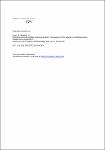Detection limit of negative staining electron microscopy for the diagnosis of bioterrorism-related micro-organisms
Laue, Michael
Bannert, Norbert
Aims: To determine the detection limit of diagnostic negative staining electron microscopy for the diagnosis of pathogens that could be used for bioterrorism. Methods and Results: Suspensions of vaccinia poxvirus and endospores of Bacillus subtilis were used at defined concentrations as a model for poxviruses and spores of anthrax (Bacillus anthracis), both of which are pathogens that could be used for bioterrorist attacks. Negative staining electron microscopy was performed directly or after sedimentation of these suspensions on to the sample supports using airfuge ultracentrifugation. For both virus and spores, the detection limit using direct adsorption of a 10-μ sample volume onto the sample support was 106 particles per ml. Using airfuge ultracentrifugation with a sample volume of 80 ll, the detection limit could be reduced to 105 particles per ml for spores and to 5 x 104 particles per ml for poxviruses. The influence on particle detection of incubation time, washing and adsorption procedures was investigated. Conclusions: The reproducibility and sensitivity of the method were acceptable, particularly considering the small sample volume and low particle number applied onto the sample support. Significance and Impact of the Study: Diagnostic negative staining electron microscopy is used for the diagnosis of pathogens in emergency situations because it allows a rapid examination of all particulate matter down to the nanometre scale. This study provides precise detection limit for the method, an important factor for the validation and improvement of the technique.
Dateien zu dieser Publikation
Keine Lizenzangabe

